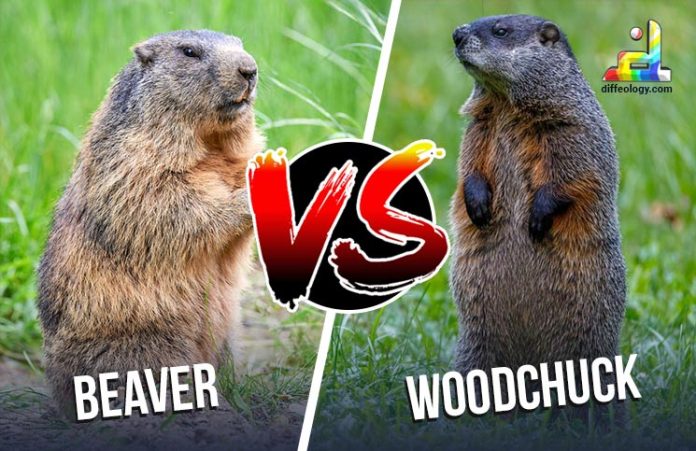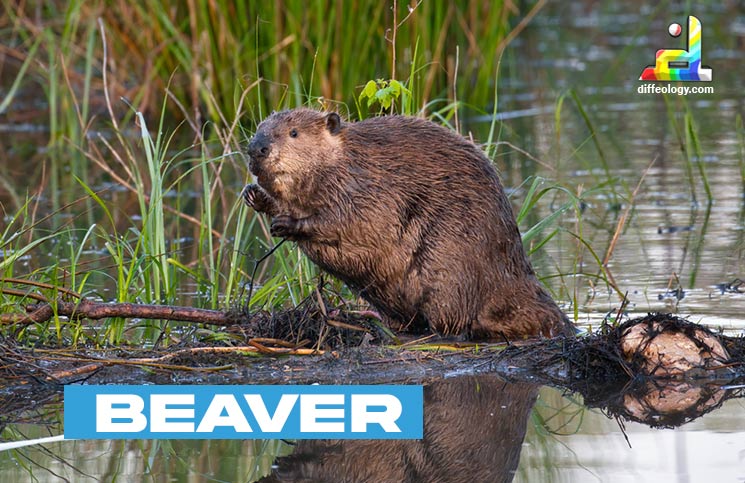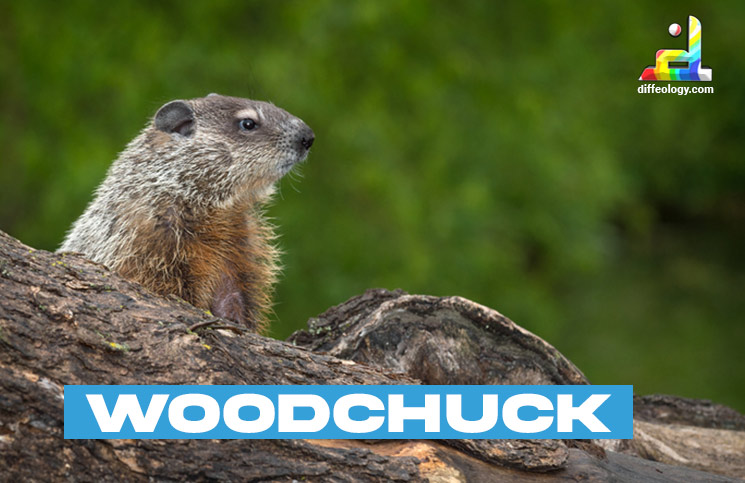The difference between Beaver and Woodchuck is obvious. They seem to be merely ordinary parts of the animal kingdom, but they certainly play unique roles in shaping their environments. Through their different ecosystems, these distinct, unique rodents help to add balance and diversity. Beavers and woodchucks appear similar, but there are crucial differences between them. In this series, we talk about their habits and habitats as well as the important work they do for nature. The beaver is a member of the rodent family Castoridae. The woodchuck is a rodent belonging to the family Sciuridae. The body is stout, the hind feet partly webbed, and the broad flat tail. Smaller body, short legs, and bushy tail.
Without question, beavers are famous as engineers skilled at building dams and transforming water landscapes. Woodchucks (groundhogs), on the other hand, live in holes that they dig for themselves below ground. What kind of contradictions exist between them, from their styles to the environment around them? Let’s find out.
The Main Difference Between Beaver and Woodchuck
Mostly aquatic, along rivers and streams or in ponds. Terrestrial woodchucks inhabit holes in the ground. The beaver uses its flat tail for swimming, waving it in the water to communicate. Bushy tail, not for swimming, but rather a warning signal. Herbivorous feeds on bark leaves and aquatic plants. Eats mostly grasses, fruit, and vegetables. Herbivorous woodchuck? Nocturnal beaver is the active type at night. Diurnal woodchuck is more active during the day.
Beaver Vs. Woodchuck
What is Beaver?
The beaver is a large, semiaquatic rodent with remarkable powers of environmental adaptation. Their stout, stocky frame features a broad, flat tail. Another of their defining characteristics is large, curved fangs that continue to grow in size throughout life. Good swimmers, with their webbed hind feet, the beavers are well suited to life in and among water. In North America and Eurasia, they are primarily distributed along rivers, streams, and ponds.
Read Also: Difference Between Goose and Swan
The beaver is renowned for its feat of dam-building skills. With sticks, mud, and stones, they build barriers across river beds or make lodges to spend the night in. They are used for protection from their predators, to control the water level in which they live and breathe, as well as to give them a conducive environment suitable for the type of herbivorous animal that they become. Since beavers influence the landscape, they are keystone species for wetland ecologies. Their industriousness and social organization make them the most interesting animals in existence.
What is woodchuck?
The woodchuck (or groundhog) is a medium-sized member of the squirrel family. They are short, thickly built, and have a fluffy tails. The woodchuck is basically terrestrial, and it does burrowing very well. Known throughout North America, they prefer dark woods, fields, and open grassland.
Read Also: Difference Between Bunny and Rabbit
It’s also a woodchuck who lives underground and has burrowing habits. Sometimes, the home will have upwards of eight rooms for sleeping, hibernating in, and raising young. In addition to being expert diggers, they are also accomplished climbers and swimmers. A herbivore, the woodchuck eats grasses, fruits and vegetables. They are famous for their connection to the folk custom of observing Groundhog Day, which involves watching whether a woodchuck will see its shadow on February 2nd and thus tell us when spring is in store. In general, woodchucks are an intriguing mixture of ground-level and aboveground animals.
Comparison Table “Beaver Vs. Woodchuck”
| Size | Larger, weighing 35 to 70 pounds. | Smaller, typically 4 to 14 pounds. |
| Tail | The flat, scaly tail is used for swimming and dam construction. | Short, bushy tail without aquatic adaptations. |
| Habitat | Semi-aquatic constructs dams in freshwater habitats. | Terrestrial, found in fields and woodlands. |
| Social Structure | Lives in family colonies with monogamous pairs. | Generally solitary, creating individual burrows. |
| Reproduction | Mates for life, forming long-term monogamous bonds. | More solitary mating system. |
| Lifespan | Can live up to 20 years in the wild. | Shorter lifespan, typically 2 to 6 years. |
| Water Adaptation | Well-adapted to aquatic life with waterproof fur. | Capable swimmers but less specialized for water. |
| Diet | Herbivorous, primarily consuming bark, twigs, and aquatic plants. | Omnivorous, feeding on vegetation, fruits, and occasionally insects. |
| Winter Behavior | Does not hibernate; survives winter by stockpiling food. | True hibernator enters torpor to conserve energy. |
| Burrowing Behavior | Constructs lodges and burrows for shelter and protection. | Excels at digging burrows in open fields and grasslands. |
| Tail Functionality | Used for swimming, navigating, and creating warning signals. | Raised defensively to appear larger when threatened. |
| Vocalization | Communicates with warning slaps, tail slaps, and vocal signals. | Less vocal communicates with low barks and whistles. |
| Maturity Age | Sexual maturity at 2 to 3 years. | Reaches sexual maturity at around 1 year. |
| Adaptation to Water | Dense, waterproof fur for insulation and buoyancy. | Capable swimmer but lacks specific aquatic adaptations. |
| Conservation Status | Generally not considered at risk; adaptable to various habitats. | Not typically endangered, adapts to human-altered landscapes. |
Difference between Beaver and Woodchuck in Detail
- Physical Appearance:
The beaver and the woodchuck are quite different in appearance. The beaver is usually smaller than the woodchuck. Adults average 35 to 70 pounds, while adults of the latter genre weigh only four to 14 pounds. The beaver’s most striking feature is its broad, flat, scaley tail. The tail is needed for swimming and also a dam-building tool. The woodchuck, on the other hand, has a short bushy tail, which is not suited to aquatic activity.
In addition, beavers ‘hind feet are also webbed for swimming, and woodchucks are more like the typical rodent foot. Color-wise, the former have dark brown fur, while woodchucks come in a variety of shades from browns to reddish-browns with a lighter belly.
- Habitat and Behavior:
Their habitats and behavior differ in another important point. The beaver is a semi-amphibious rodent who builds dams in freshwater environments. To ensure easy access to food in winter, they build dams out of branches and mud, which form ponds for them. Beavers are very adept at modifying the environment around them, and they build intricate lodges.
In contrast, the woodchuck (groundhog), whose exact origin has not yet been determined, is a creature of land and open ground. They are good diggers and excavate holes in which they spend the winter. However, unlike beavers, woodchucks are not for dam-builders and water engineers.
- Diet and Feeding Habits:
The beaver and the woodchuck have different tastes in food, as well. Beavers are vegetarian animals that usually feed on bark, twigs, and leaves of trees, as well as aquatic plants. They have powerful chisel-like incisors which enable them to slice down trees and break up wood for eating. They are especially noted for stripping the bark from trees, a tendency that has got them labeled as industrious builders.
Woodchucks, on the other hand, have a much more mixed diet, eating both vegetation and fruit (plus some insects occasionally). Grass, clover, berries, and crops make up their diet. Unlike beavers, the woodchuck does not fill large quantities of wood for dam construction.
- Social Structure:
The beaver and woodchuck differ in their social organizations. Family colonies Beavers are highly family-oriented, including the adult pair (one male and one female) and their offspring in one colony. Dam building and lodge construction are activities for all of these colonies, which yields a cooperative group lifestyle. Family relations The family is the key to the survival and success of a beaver colony.
On the other hand, woodchucks are more solitary creatures. Their burrows are their individual dwellings, and though woodchucks may overlap each other’s territories at times, contact outside of mating season is seldom. Beavers, on the other hand, live together in family groups and are relatively more sociable than woodchucks.
- Reproductive Patterns:
The two differ in their reproductive habits and also how they bring up their young. Most beavers are monogamous, maintaining long-term partnerships. Mating season is in January or February, and nearly three months later, the female beavers give birth to their kits. The parents take an active part in looking after and protecting the young.
The mating system of the woodchuck, on the other hand, is more solitary. Mating season is in early spring. After about a month’s gestation period, the female woodchuck produces one litter of two to six pups. The female cares for the young herself, and they remain in the burrow until big enough to strike out on their own.
- Vocalization and Communication:
Beavers ‘and woodchucks’ modes of communication reflect their different ways of life. Vocalizations Beavers have many sounds. Apart from the slaps on the water to warn or threaten others, beavers also make vocal expressions of whining and growling around their faces. These vocalizations serve to organize activities in the beaver colony and communicate about potential danger.
But woodchucks are usually not as vocal. They use low barks and whistles to communicate, especially during the mating season when looking for partners or warning of danger. Although vocalizations are part of their means of communication, woodchucks mainly rely on body language and scent marking to communicate information with fellow residents in the local area.
- Tail Functionality:
Beavers ‘and woodchucks’ tails differ in function and structure. The beaver’s tail is flat, scaly, and huge; it can serve a variety of purposes. It is an essential part of swimming, functioning as a type of steering mechanism. Beaver’s tail is also employed in dam-building, where it packs mud into place.
For example, a woodchuck’s tail is short and bushy instead of flattened like the beaver’s. Although it lacks the aquatic functions of a beaver’s tail, it does serve to communicate. If a woodchuck is scared or in danger of being eaten, it will stand up to bluff its way out–it has the habit of lifting its tail and making itself look bigger.
- Lifespan and Maturity:
Differences in the lifespans and age of sexual maturity between beavers and woodchucks are also evident. On average, beavers live longer than the woodchuck. Beavers in the wild can live 20 years, while woodchucks only have a life expectancy of two to six years. Longevity is another characteristic that helps the beaver maintain a long-term family relationship and build up large areas of habitat.
The sexual maturity of the two species is also different. The beavers are sexually mature at the age of two or three years, so they may partake in colony reproduction quite early on. But woodchucks, on the other hand, become sexually mature at one year old. Their different ages of maturation correspond to the differences in their reproductive strategy and social behavior.
- Adaptation to Water:
Other adaptations to an aquatic way of life also set them apart from woodchucks. The beaver is particularly well-adapted for a life close to water. How is it that their fur insulates and repels water while they are swimming? Furthermore, valves in their eyes and nostrils prevent them from filling with water so they can keep diving even when foraging or repairing the dam.
Though woodchucks can also swim, they are not as adapted for aquatic life. Their fur is not waterproof, and their body isn’t as streamlined as that of the beaver. Except for fleeing from their pursuers or venturing into unfamiliar territory, the woodchuck’s aquatic activities are limited to swimming. It is not like other animals, which do many adventurous things in water, such as building dams.
- Winter Behavior:
The winter habits of the beaver and woodchuck show how these two creatures have adopted different survival strategies to cope with the same cold weather. As beavers do not hibernate, they have excellent equipment for surviving the winter. Instead, they stockpile food in preparation for the cold months near their lodges. The lodges are, of course, insulated, and the beavers can get to their food by swimming underwater, covered with ice.
But woodchucks, by contrast, are real hibernators. When winter arrives, they hibernate in their dens, where the metabolism is low and energy can be saved. A woodchuck’s heart rate falls dramatically during hibernation, as does its need for food; it lives on stored body fat. With this hibernation strategy, the woodchuck can weather food shortages in winter.
- Conservation Status:
Fears for woodchuck numbers are different from those regarding beavers, and conservation policies differ accordingly. However, because of their adaptability and the fact that they can survive in a wide variety of habitats, beavers are not considered endangered. Indeed, there are successful examples of conservation and repopulation efforts that have led to a revival in beaver populations.
While not generally endangered, woodchucks can become threatened on a local basis in some areas as the result of habitat disruptions caused by manmade development. But living around human-made environments usually allows them to establish steady numbers. Roaming in many different ecosystems. To cope with this crisis, conservation workers can prevent the extinction of woodchucks by preserving open spaces and preventing habitat fragmentation.
Key Points Showing the Difference between Beaver and Woodchuck
- Construction Skills: Beaver Builds dams and lodges using sticks, mud, and stones. Woodchuck Creates burrows in the ground for shelter.
- Social Structure: Beaver Lives in family groups, with a monogamous pair and their offspring. Woodchucks are Solitary creatures except during the mating season.
- Swimming Ability: Beavers are Excellent swimmers, aided by their webbed hind feet. Woodchucks can swim but are not as proficient; they prefer to stay on land.
- Hibernate or Not: Beaver Does not hibernate; it remains active throughout the winter. Woodchucks Undergo hibernation during the winter months.
- Burrow Complexity: Beaver Constructs elaborate lodges and burrows with underwater entrances. Woodchucks Dig simple burrows with multiple chambers for different purposes.
- Range: Beaver is found in both North America and Eurasia. Woodchuck is Primarily found in North America.
- Nuisance Behavior: Beavers can cause flooding with their dam-building activities. Woodchucks are Sometimes considered a garden pest due to burrow digging.
- Teeth and Chewing Habits: Beaver Has large, sharp incisors for gnawing on wood and bark. Woodchuck Also possesses incisors but is not known for extensive wood-chewing behavior.
- Life Span: Beaver Generally has a longer lifespan, living up to 20 years in captivity. Woodchucks typically live around 3-6 years in the wild.
- Vocalizations: Beaver Communicates with a variety of vocalizations, including warning signals. Woodchuck Makes a distinctive whistle-like sound, often called a “chuck.”
- Predation Risk: Beavers are Less vulnerable to predators due to their large size and aquatic habitat. Woodchuck Faces higher predation risks, especially from birds of prey and carnivores.
- Grooming Behavior: Beaver Exhibits meticulous grooming habits, keeping its fur waterproof. Woodchuck Grooms itself but doesn’t rely on waterproofing for survival.
- Tail Usage on Land: Beaver Drags its tail on land; it doesn’t impede movement. Woodchuck Does not use its tail for communication on land; it’s more for balance.
FAQs: Beaver Vs. Woodchuck
Conclusion:
Everything has its purpose. Even the most insignificant species ultimately play a part in our ecosystems as that giant tapestry gets woven. Beavers and woodchucks demonstrate in many ways the variety that makes our natural world so magical. This kind of understanding naturally helps us to appreciate the differences and similarities between these two creatures ‘habitats.
In a universe of beavers and woodchucks, it is important for people to carry within themselves the requiem of coexistence. There is a difference between Beaver and Woodchuck, but by no means are they unrelated creatures existing in the same web of life. Understanding and valuing the work they do in their own habitats can help us develop greater intimacy with nature. Thus, let us applaud the beavers and their dams and cheer for those woodchucks digging tunnels under our feet.
References & External Links
- Facts About Beaver
- Woodchuck (Groundhog) Photos and Facts






